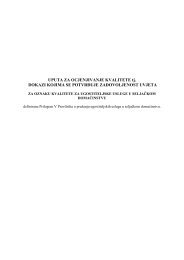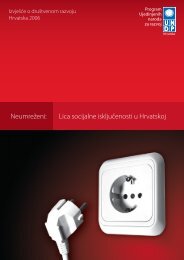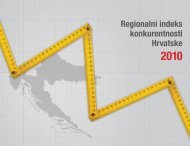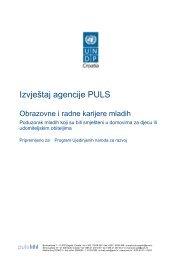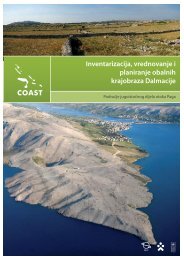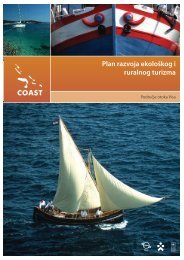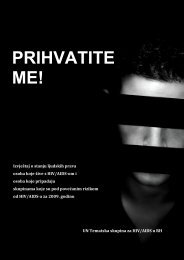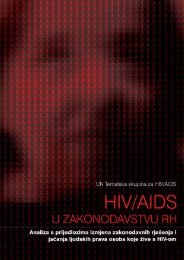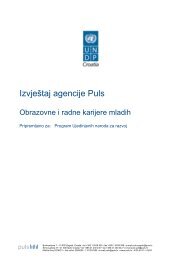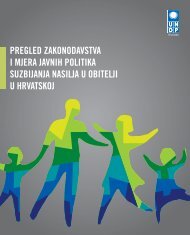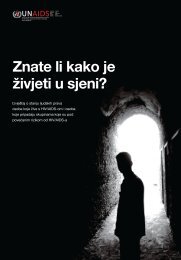WEB engleska verzija end.indd - UNDP Croatia
WEB engleska verzija end.indd - UNDP Croatia
WEB engleska verzija end.indd - UNDP Croatia
- No tags were found...
You also want an ePaper? Increase the reach of your titles
YUMPU automatically turns print PDFs into web optimized ePapers that Google loves.
CHAPTER 3THE SOCIALLY EXCLUDED56residing in the collective centres since they are consideredto be under ODPR care and as such cannotbe under the state social welfare. Upon expirationof their returnee status, returnees in need of institutionalcare fall into an assistance gap as their transferfrom ODPR care to social welfare is not automatic.The transfer from an ODPR facility to a social welfarefacility is cumbersome given the lack of coordinationbetween ODPR and Social Welfare and the limitedcapacities of institutions.3.3.3 Access to HealthcareAlthough the present health system promotes equalaccess to healthcare for all citizens, part of the populationis not able to utilize this right. This is particularlytrue for refugees, returnees and other <strong>Croatia</strong>ncitizens who, for various reasons, do not have healthinsurance. The available data demonstrates that acertain number of people from these groups do notfulfil the legal requirements for health insurance,while others could benefit from the national healthinsurance system but lack the necessary informationand assistance. Returnees are often part of the lattergroup. They t<strong>end</strong> to face delays in obtaining fullaccess to state health services, including insurance,immediately upon their return, due to administrativeprocedures. Typically, their healthcare applies only toemergency situations. The lack of advocacy servicesto uninsured returnees admitted to hospitals, associatedwith the occasional lack of awareness about theirrights in healthcare, frequently results in unnecessarypayment of services directly by the beneficiaries.The new Law on Health Insurance (Narodne novine,no 85/06) which came into force on 3 August 2006does not recognise the special category of returneeas did the previous Law on Health Insurance. The categoryof returnees is interpreted in the present Lawas “others”, who are obliged to pay health insurancecontributions for at least 12 months retroactively.3.3.4 Access to EducationThe right to education in an unofficial language isguaranteed in the 2002 Constitutional Law on theRights of National Minorities (CLNM) and other relevantlegislation. These laws provide minorities witha generous and liberal framework by which a specificminority education for their children is provided.Article 1 of the CLNM allows members of nationalminorities to establish kindergartens, primary andsecondary schools and institutions of higher educationspecific to their language and cultural traditions.The Ministry of Science, Education and Sport hasadopted three basic models for minority education:Model A – all teaching is done in the language of agiven national minority, with an additional four hoursper week of <strong>Croatia</strong>n language classes. The regularcurriculum is translated into the minority languageand supplemented by topics related to the specialcharacteristics of a given minority. Teaching is performedin separate schools or in special classes inmajority schools.Model B – teaching is bilingual. Natural sciences aretaught in <strong>Croatia</strong>n while humanities are taught in therelevant minority language. This form of education ismostly organized in regular schools through specialclasses.Model C – in addition to the full educational syllabustaught in <strong>Croatia</strong>n, minority students have anadditional five hours per week of lessons related tothe culture, language and history of their specificminority group.The physical separation betweenchildren in the Danube RegionSince the peaceful reintegration of the DanubeRegion, minority education has been a particularlysensitive issue. In Vukovar-Srijem County and Osijek-Baranja County, education Models A and C are in useby Serbs, Hungarians, Slovaks, Germans, Rutheniansand Ukrainians. In the 2005/06 academic year approximately5,000 minority students were included ineducation Models A or C in kindergarten, primary andsecondary schools. Most children of Serb ethnicity areenrolled in educational Model A, with a small numberenrolled in Model C classes. Until recently, Croat andSerb students remained physically separated in manykindergartens and schools in the town of Vukovar,despite the fact that more than 80% of parents wouldprefer mixed education for their children accordingto a survey conducted by an Osijek-based NGO - theNansen Dialogue Centre. The situation outside Vuk-



